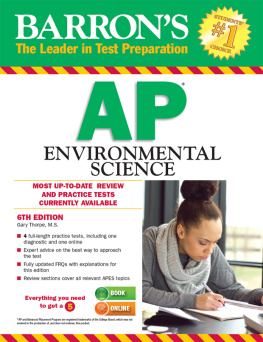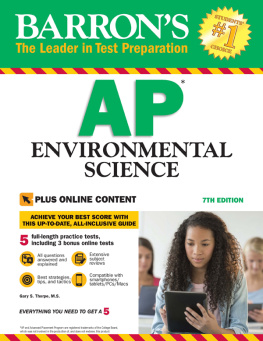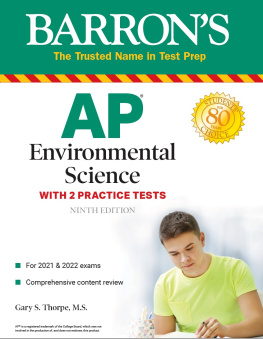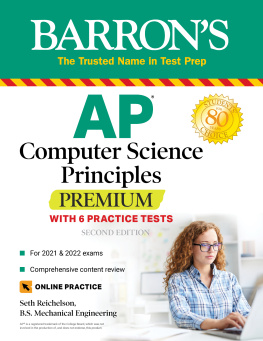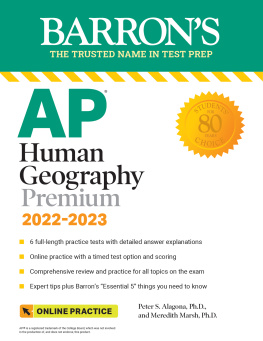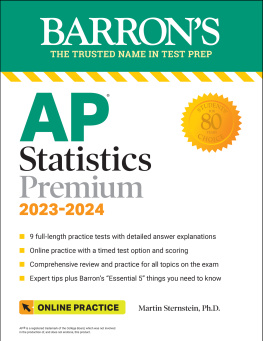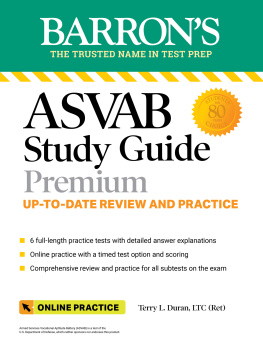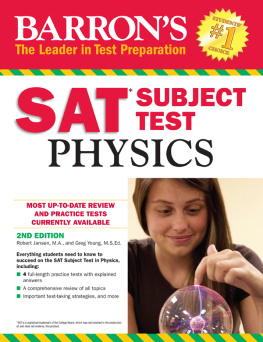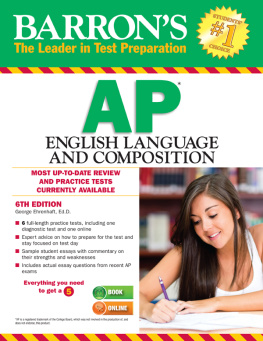
Now Available!

Go to barronsbooks.com/AP/envsci/ to take a free sample AP Environmental Science test, complete with answer explanations and automated scoring.
*This online test was created for devices that support Adobe Flash Player. To access the test on an Apple iPad or iPhone you will need to install a web browser that supports Flash (check the iTunes App Store for free options).
ACKNOWLEDGMENTS
I would like to thank my wife, Patti, and my two daughters, Kris and Erin, for their patience and understanding while I was writing this book. This book is dedicated in tribute to the late Dr. Jerry Bobrow of Bobrow Test Preparation Services, who was not only my publishing agent but a dear friend for many years. A special thanks also goes to the many professional and dedicated high school APES teachers across the United States who contributed their finest work in making this book possible.
Copyright 2015, 2013, 2011, 2009, 2007 by Barrons Educational Series, Inc.
Previous edition copyright 2002 under the title How to Prepare for the AP Environmental Science Exam by Barrons Educational Series, Inc.
All rights reserved.
No part of this product may be reproduced in any form or by any means without the written permission of the copyright owner.
All inquiries should be addressed to:
Barrons Educational Series, Inc.
250 Wireless Boulevard
Hauppauge, New York 11788
www.barronseduc.com
eISBN: 978-1-4380-6728-5
Revised e-Book publication, March, 2015
CONTENTS
As you review the content in this book and work toward earning that on your AP ENVIRONMENTAL SCIENCE exam, here are five things that you MUST do: |
Practice writing your own answers to the Free-Response Questions (FRQs). After you review each FRQ, close this book and write your own response to the question. Then, compare your answer to the one in the book. The more you practice writing your own essays, the higher your score will be on the actual APES exam.
Be sure to review the Case Studies presented in this book. You will find several questions on the exam that focus on specific events that have occurred throughout history and involve environmental science principles and issues. When possible, reference these Case Studies in your responses to the FRQs.
Thoroughly review Chapters 9 (Pollution) and 10 (Impacts on the Environment and Human Health). About 2530% of the multiple-choice questions on the APES exam will test your knowledge of the topics in these chapters. In particular,
Be familiar with the differences between industrial and photochemical smog.
Know the causes and effects of acid deposition.
Know the causes and effects of global warming.
Familiarize yourself with remediation and reduction strategies for environmental pollution.
Become comfortable with doing the types of math problems found in this book, especially those involving energy calculations. These problems are found in Chapter 8 and in both practice exams. Historically, question 1 of the FRQ section of the APES exam frequently requires you to complete mathematical calculations.
Review the relevant acts, laws, and treaties detailed in each chapter. You will find several questions on the APES exam that test your knowledge on them; you can also reference them in your answers to the FRQs when appropriate.
This e-Book may appear differently depending on which device you are using to view it on. Please adjust your device accordingly.
Since this is an e-Book, it contains hyperlinks that help you navigate through the content, bring you to helpful Internet resources, and allow you to click between questions and answers.

T his 6th edition includes many new and important features: (1) a diagnostic test that consists of 100 multiple-choice questions with all answers explained. At the end of the diagnostic test, a predictive rubric developed by the College Board will allow you to predict your final score on the APES exam; (2) all chapters have been fully updated to reflect recent changes in environmental laws; (3) case studies have been updated to reflect events that have recently occurred; e.g., the 2011 earthquake and tsunami that hit Japan and the severe tornadoes that occurred in the United States in 20112012; (4) new charts have been re-formatted for students to make reviewing for the APES exam easier; (5) Quick Review Checklists, which list the most important topics covered in each chapter, have been added. You can use the checklists to mark your progress in reviewing each topic; (6) a new Vocabulary Review for each chapter provides you with a handy list of the most important vocabulary words and definitions that you can review just before the exam; and finally (7) the 6th edition is available as a book/CD set that contains two additional APES exams with fully explained answers. Combine this 6th edition book and CD with Barrons AP Environmental Science Flash Cards and youll have everything you need to fully prepare yourself for the exam. No other APES review on the market today comes close to all that is included in this book.
INTRODUCTORY MATERIAL
The introductory material contains information on the AP exam itself. It includes commonly asked questions, strategies for taking the exam, and techniques for writing outstanding essays.
SPECIFIC TOPICS
The majority of this book is divided into seven units. Each contains specific chapters on material covered on the APES exam. Each chapter provides a condensed review of key information, updated case studies, relevant and updated environmental laws, a topic-specific vocabulary list including definitions, multiple-choice questions, and free-response essay questions similar to the questions found on actual APES exams. Many of the free-response questions and explanations have been contributed by award-winning APES teachers from across the United States.
PRACTICE EXAMS
The last part of this book contains two complete practice APES exams. All questions are thoroughly explained and the free-response questions provide a rubric for scoring your answers along with tips on how to score even higher.
If you have purchased a book that contains the CD-ROM, the software contains two additional practice tests and answers so you can practice taking the test under timed conditions and receive immediate scoring.

T he APES exam is three hours long and is divided equally in time between a multiple-choice section and a free-response section. The multiple-choice section, which makes up 60% of the final score and lasts 90 minutes, consists of 100 multiple-choice questions and is designed to cover your knowledge and understanding of environmental science. Thought-provoking problems and questions based on fundamental ideas are included along with questions based on the recall of basic facts and major concepts. The number of multiple-choice questions taken from each major topic area is reflected in the percentages shown in Topics Covered on the Exam found later in this section. For example, in Earth Systems and Resources, you will see (1015%). Expect to find 10 to 15 multiple-choice questions from this area on the actual APES exam. Therefore, spend about 1015% of your time reviewing this area.
The free-response section, which is also 90 minutes long, makes up 40% of your final score. It contains one data set question, one document-based question, and two synthesis and evaluation questions. The differences between these types of free-response questions will be explained later in this introductory section. You must organize your answers to demonstrate reasoning and analytical skills, as well as the ability to write clearly and concisely.
Next page
